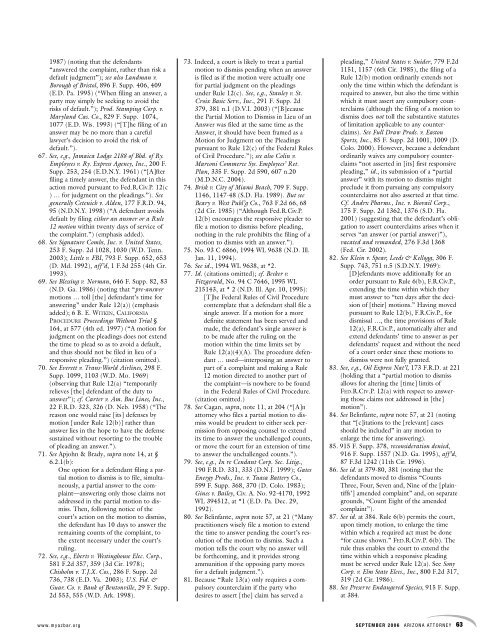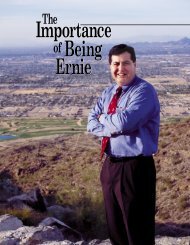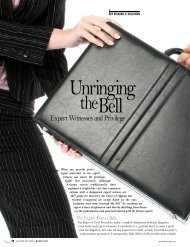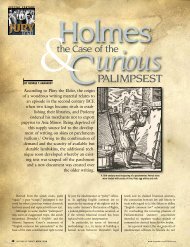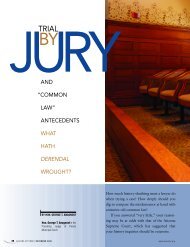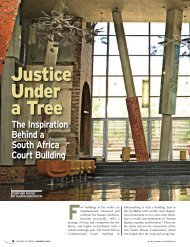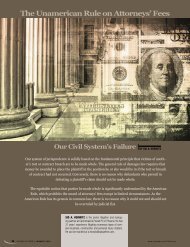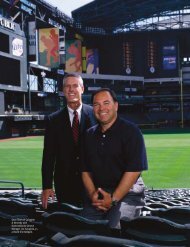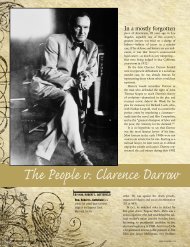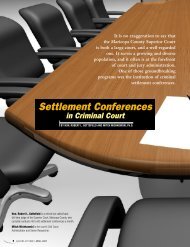The Partial Motion To Dismiss and the Defendant's ... - Lawyers
The Partial Motion To Dismiss and the Defendant's ... - Lawyers
The Partial Motion To Dismiss and the Defendant's ... - Lawyers
You also want an ePaper? Increase the reach of your titles
YUMPU automatically turns print PDFs into web optimized ePapers that Google loves.
1987) (noting that <strong>the</strong> defendants“answered <strong>the</strong> complaint, ra<strong>the</strong>r than risk adefault judgment”); see also L<strong>and</strong>man v.Borough of Bristol, 896 F. Supp. 406, 409(E.D. Pa. 1995) (“When filing an answer, aparty may simply be seeking to avoid <strong>the</strong>risks of default.”); Prod. Stamping Corp. v.Maryl<strong>and</strong> Cas. Co., 829 F. Supp. 1074,1077 (E.D. Wis. 1993) (“[T]he filing of ananswer may be no more than a carefullawyer’s decision to avoid <strong>the</strong> risk ofdefault.”).67. See, e.g., Jamaica Lodge 2188 of Bhd. of Ry.Employees v. Ry. Express Agency, Inc., 200 F.Supp. 253, 254 (E.D.N.Y. 1961) (“[A]fterfiling a timely answer, <strong>the</strong> defendant in thisaction moved pursuant to Fed.R.Civ.P. 12(c) … for judgment on <strong>the</strong> pleadings.”). Seegenerally Cetenich v. Alden, 177 F.R.D. 94,95 (N.D.N.Y. 1998) (“A defendant avoidsdefault by filing ei<strong>the</strong>r an answer or a Rule12 motion within twenty days of service of<strong>the</strong> complaint.”) (emphasis added).68. See Signature Combs, Inc. v. United States,253 F. Supp. 2d 1028, 1030 (W.D. Tenn.2003); Little v. FBI, 793 F. Supp. 652, 653(D. Md. 1992), aff’d, 1 F.3d 255 (4th Cir.1993).69. See Blessing v. Norman, 646 F. Supp. 82, 83(N.D. Ga. 1986) (noting that “pre-answermotions … toll [<strong>the</strong>] defendant’s time foranswering” under Rule 12(a)) (emphasisadded); 6 B. E. WITKIN, CALIFORNIAPROCEDURE Proceedings Without Trial §164, at 577 (4th ed. 1997) (“A motion forjudgment on <strong>the</strong> pleadings does not extend<strong>the</strong> time to plead so as to avoid a default,<strong>and</strong> thus should not be filed in lieu of aresponsive pleading.”) (citation omitted).70. See Everett v. Trans-World Airlines, 298 F.Supp. 1099, 1103 (W.D. Mo. 1969)(observing that Rule 12(a) “temporarilyrelieves [<strong>the</strong>] defendant of <strong>the</strong> duty toanswer”); cf. Carter v. Am. Bus Lines, Inc.,22 F.R.D. 323, 326 (D. Neb. 1958) (“<strong>The</strong>reason one would raise [its] defenses bymotion [under Rule 12(b)] ra<strong>the</strong>r thananswer lies in <strong>the</strong> hope to have <strong>the</strong> defensesustained without resorting to <strong>the</strong> troubleof pleading an answer.”).71. See Apjohn & Brady, supra note 14, at §6.2.1(b):One option for a defendant filing a partialmotion to dismiss is to file, simultaneously,a partial answer to <strong>the</strong> complaint—answeringonly those claims notaddressed in <strong>the</strong> partial motion to dismiss.<strong>The</strong>n, following notice of <strong>the</strong>court’s action on <strong>the</strong> motion to dismiss,<strong>the</strong> defendant has 10 days to answer <strong>the</strong>remaining counts of <strong>the</strong> complaint, to<strong>the</strong> extent necessary under <strong>the</strong> court’sruling.72. See, e.g., Eberts v. Westinghouse Elec. Corp.,581 F.2d 357, 359 (3d Cir. 1978);Chisholm v. T.J.X. Cos., 286 F. Supp. 2d736, 738 (E.D. Va. 2003); U.S. Fid. &Guar. Co. v. Bank of Bentonville, 29 F. Supp.2d 553, 555 (W.D. Ark. 1998).73. Indeed, a court is likely to treat a partialmotion to dismiss pending when an answeris filed as if <strong>the</strong> motion were actually onefor partial judgment on <strong>the</strong> pleadingsunder Rule 12(c). See, e.g., Stanley v. St.Croix Basic Serv., Inc., 291 F. Supp. 2d379, 381 n.1 (D.V.I. 2003) (“[B]ecause<strong>the</strong> <strong>Partial</strong> <strong>Motion</strong> to <strong>Dismiss</strong> in Lieu of anAnswer was filed at <strong>the</strong> same time as <strong>the</strong>Answer, it should have been framed as a<strong>Motion</strong> for Judgment on <strong>the</strong> Pleadingspursuant to Rule 12(c) of <strong>the</strong> Federal Rulesof Civil Procedure.”); see also Colin v.Marconi Commerce Sys. Employees’ Ret.Plan, 335 F. Supp. 2d 590, 607 n.20(M.D.N.C. 2004).74. Brisk v. City of Miami Beach, 709 F. Supp.1146, 1147-48 (S.D. Fla. 1989). But seeBeary v. West Publ’g Co., 763 F.2d 66, 68(2d Cir. 1985) (“Although Fed.R.Civ.P.12(b) encourages <strong>the</strong> responsive pleader tofile a motion to dismiss before pleading,nothing in <strong>the</strong> rule prohibits <strong>the</strong> filing of amotion to dismiss with an answer.”).75. No. 93 C 6866, 1994 WL 9638 (N.D. Ill.Jan. 11, 1994).76. See id., 1994 WL 9638, at *2.77. Id. (citations omitted); cf. Becker v.Fitzgerald, No. 94 C 7646, 1995 WL215143, at * 2 (N.D. Ill. Apr. 10, 1995):[T]he Federal Rules of Civil Procedurecontemplate that a defendant shall file asingle answer. If a motion for a moredefinite statement has been served <strong>and</strong>made, <strong>the</strong> defendant’s single answer isto be made after <strong>the</strong> ruling on <strong>the</strong>motion within <strong>the</strong> time limits set byRule 12(a)(4)(A). <strong>The</strong> procedure defendant… used—interposing an answer topart of a complaint <strong>and</strong> making a Rule12 motion directed to ano<strong>the</strong>r part of<strong>the</strong> complaint—is nowhere to be foundin <strong>the</strong> Federal Rules of Civil Procedure.(citation omitted.)78. See Cagan, supra, note 11, at 204 (“[A]nattorney who files a partial motion to dismisswould be prudent to ei<strong>the</strong>r seek permissionfrom opposing counsel to extendits time to answer <strong>the</strong> unchallenged counts,or move <strong>the</strong> court for an extension of timeto answer <strong>the</strong> unchallenged counts.”).79. See, e.g., In re Cendant Corp. Sec. Litig.,190 F.R.D. 331, 333 (D.N.J. 1999); GatesEnergy Prods., Inc. v. Yuasa Battery Co.,599 F. Supp. 368, 370 (D. Colo. 1983);Gines v. Bailey, Civ. A. No. 92-4170, 1992WL 394512, at *1 (E.D. Pa. Dec. 29,1992).80. See Belinfante, supra note 57, at 21 (“Manypractitioners wisely file a motion to extend<strong>the</strong> time to answer pending <strong>the</strong> court’s resolutionof <strong>the</strong> motion to dismiss. Such amotion tells <strong>the</strong> court why no answer willbe forthcoming, <strong>and</strong> it provides strongammunition if <strong>the</strong> opposing party movesfor a default judgment.”).81. Because “Rule 13(a) only requires a compulsorycounterclaim if <strong>the</strong> party whodesires to assert [<strong>the</strong>] claim has served apleading,” United States v. Snider, 779 F.2d1151, 1157 (6th Cir. 1985), <strong>the</strong> filing of aRule 12(b) motion ordinarily extends notonly <strong>the</strong> time within which <strong>the</strong> defendant isrequired to answer, but also <strong>the</strong> time withinwhich it must assert any compulsory counterclaims(although <strong>the</strong> filing of a motion todismiss does not toll <strong>the</strong> substantive statutesof limitation applicable to any counterclaims).See Full Draw Prods. v. EastonSports, Inc., 85 F. Supp. 2d 1001, 1009 (D.Colo. 2000). However, because a defendantordinarily waives any compulsory counterclaims“not asserted in [its] first responsivepleading,” id., its submission of a “partialanswer” with its motion to dismiss mightpreclude it from pursuing any compulsorycounterclaims not also asserted at that time.Cf. Andrx Pharms., Inc. v. Biovail Corp.,175 F. Supp. 2d 1362, 1376 (S.D. Fla.2001) (suggesting that <strong>the</strong> defendant’s obligationto assert counterclaims arises when itserves “an answer (or partial answer)”),vacated <strong>and</strong> rem<strong>and</strong>ed, 276 F.3d 1368(Fed. Cir. 2002).82. See Klein v. Spear, Leeds & Kellogg, 306 F.Supp. 743, 751 n.5 (S.D.N.Y. 1969):[D]efendants move additionally for anorder pursuant to Rule 6(b), F.R.Civ.P.,extending <strong>the</strong> time within which <strong>the</strong>ymust answer to “ten days after <strong>the</strong> decisionof [<strong>the</strong>ir] motions.” Having movedpursuant to Rule 12(b), F.R.Civ.P., fordismissal …, <strong>the</strong> time provisions of Rule12(a), F.R.Civ.P., automatically alter <strong>and</strong>extend defendants’ time to answer as perdefendants’ request <strong>and</strong> without <strong>the</strong> needof a court order since <strong>the</strong>se motions todismiss were not fully granted.83. See, e.g., Oil Express Nat’l, 173 F.R.D. at 221(holding that a “partial motion to dismissallows for altering <strong>the</strong> [time] limits ofFED.R.CIV.P. 12(a) with respect to answeringthose claims not addressed in [<strong>the</strong>]motion”).84. See Belinfante, supra note 57, at 21 (notingthat “[c]itations to <strong>the</strong> [relevant] casesshould be included” in any motion toenlarge <strong>the</strong> time for answering).85. 915 F. Supp. 378, reconsideration denied,916 F. Supp. 1557 (N.D. Ga. 1995), aff’d,87 F.3d 1242 (11th Cir. 1996).86. See id. at 379-80, 381 (noting that <strong>the</strong>defendants moved to dismiss “CountsThree, Four, Seven <strong>and</strong>, Nine of <strong>the</strong> [plaintiffs’]amended complaint” <strong>and</strong>, on separategrounds, “Count Eight of <strong>the</strong> amendedcomplaint”).87. See id. at 384. Rule 6(b) permits <strong>the</strong> court,upon timely motion, to enlarge <strong>the</strong> timewithin which a required act must be done“for cause shown.” FED.R.CIV.P. 6(b). <strong>The</strong>rule thus enables <strong>the</strong> court to extend <strong>the</strong>time within which a responsive pleadingmust be served under Rule 12(a). See SonyCorp. v. Elm State Elecs., Inc., 800 F.2d 317,319 (2d Cir. 1986).88. See Preserve Endangered Species, 915 F. Supp.at 384.www.myazbar.org SEPTEMBER 2006 ARIZONA ATTORNEY 63


